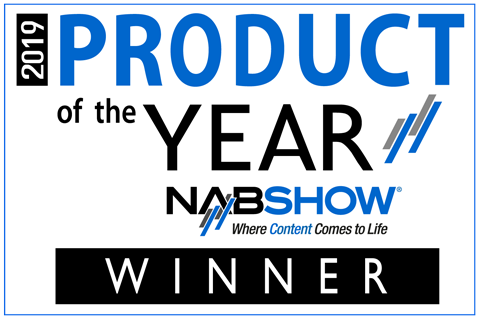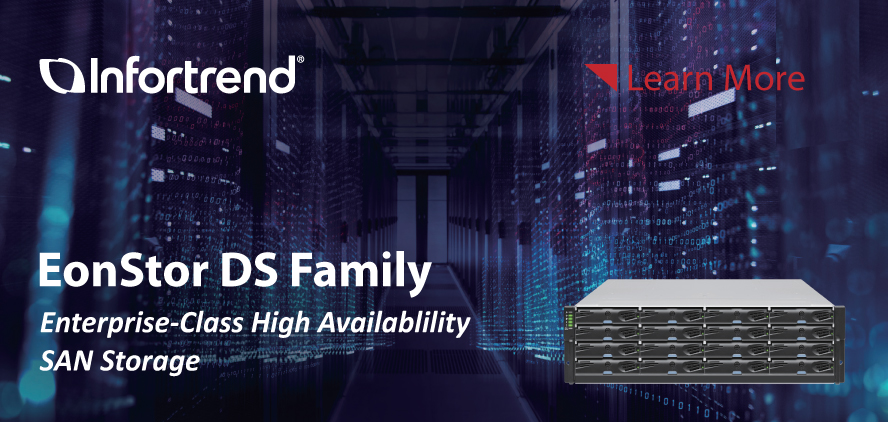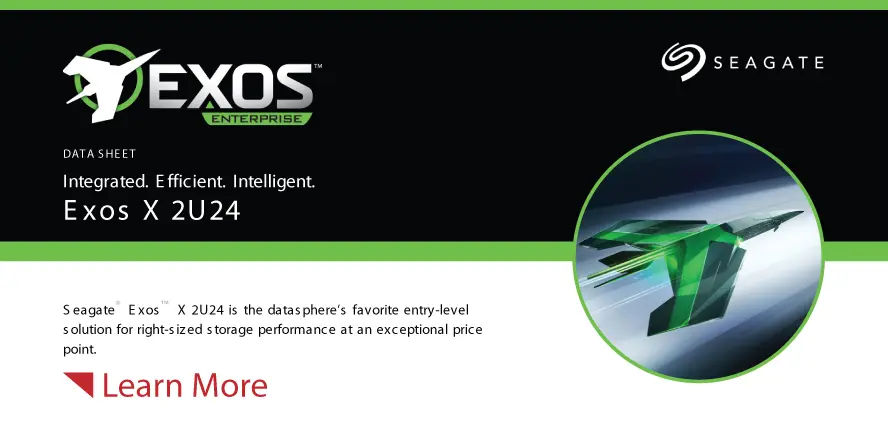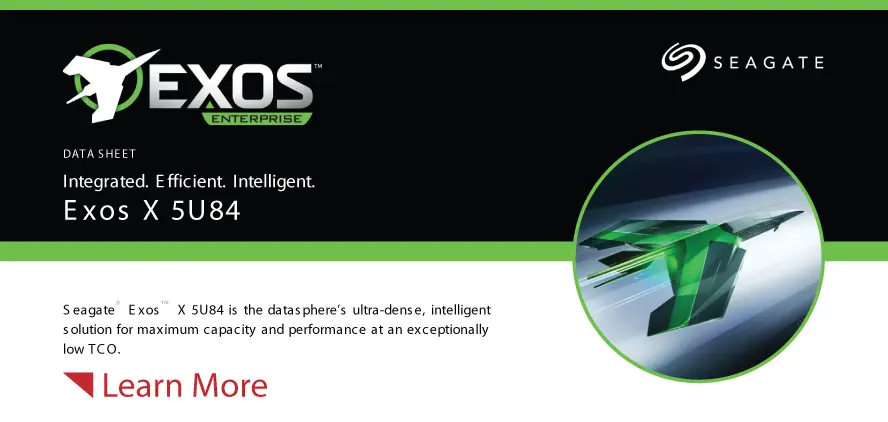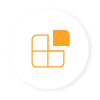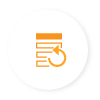
Read the Datasheet
The HA DDP solutions with Project Caching consists of the Dual HA DDPHead (Read the Datasheet) with the A/V FS file system and raid arrays with NVME or SAS SSDs in combination with hard disks.
A/V FS is famous for Project Caching. It gives the best of both worlds: SSD performance with hard disk capacity. M & E organizes media in projects. For each project a folder or folder structure is created. Per project it can be decided where and how to store, cache or clear cached data without disturbing the workflow. This can be automated or controlled manually.
Without Project Caching the systems below would be either all SSDs or hard disks. SSD systems are small sized, are A/V format independent and have a low energy footprint while hard disk systems have a large size, are A/V format dependent and are energy hungry.
See here some network configurations
With Project Caching the SSD performance is guaranteed and the hard disk capacity can be filled in within certain boundaries by using the highest capacity to number ratio. That way a DDP system with a proper balance between performance, size, price and energy footprint can be offered.
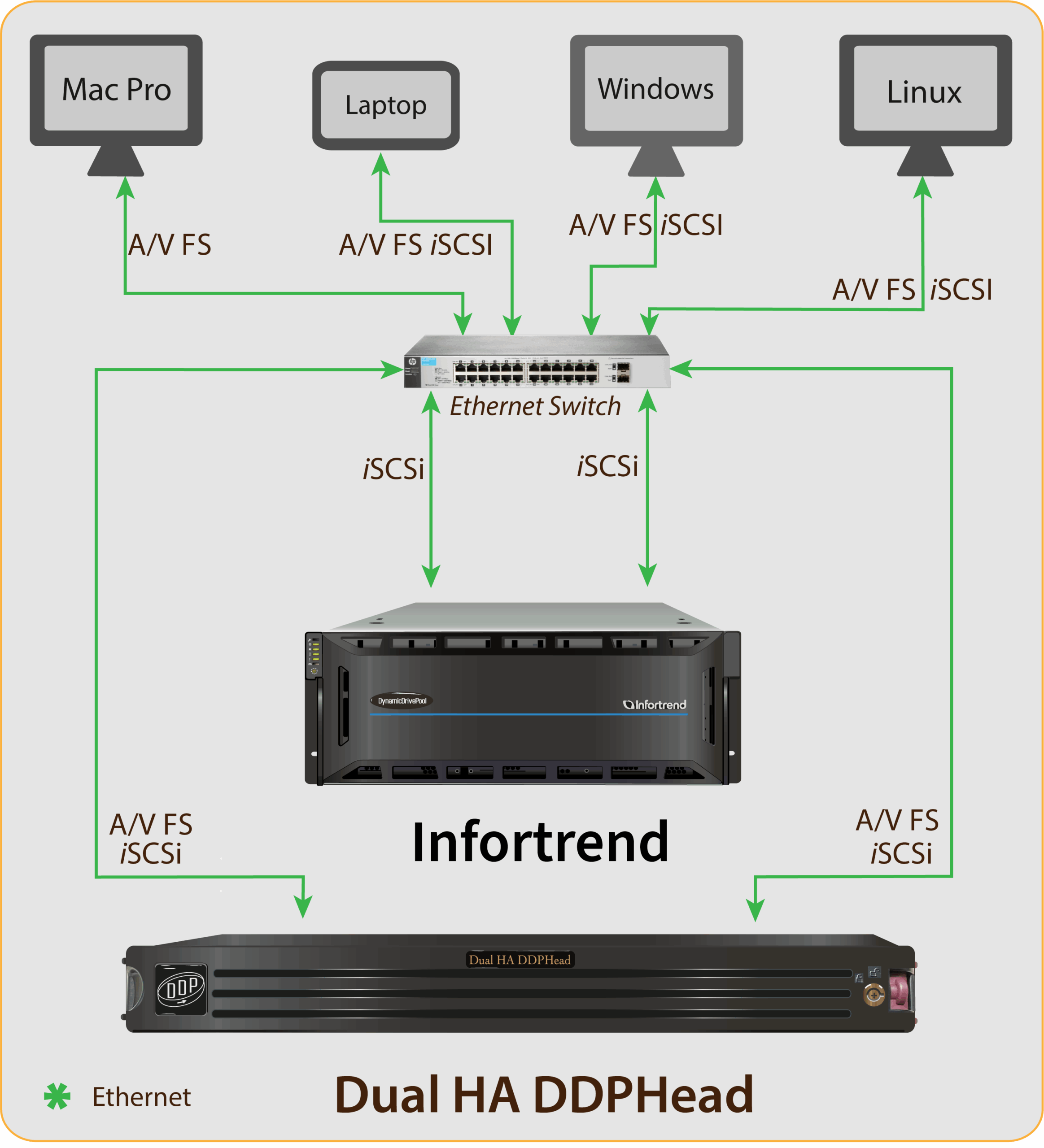
All Ethernet with DS
& Infortrend
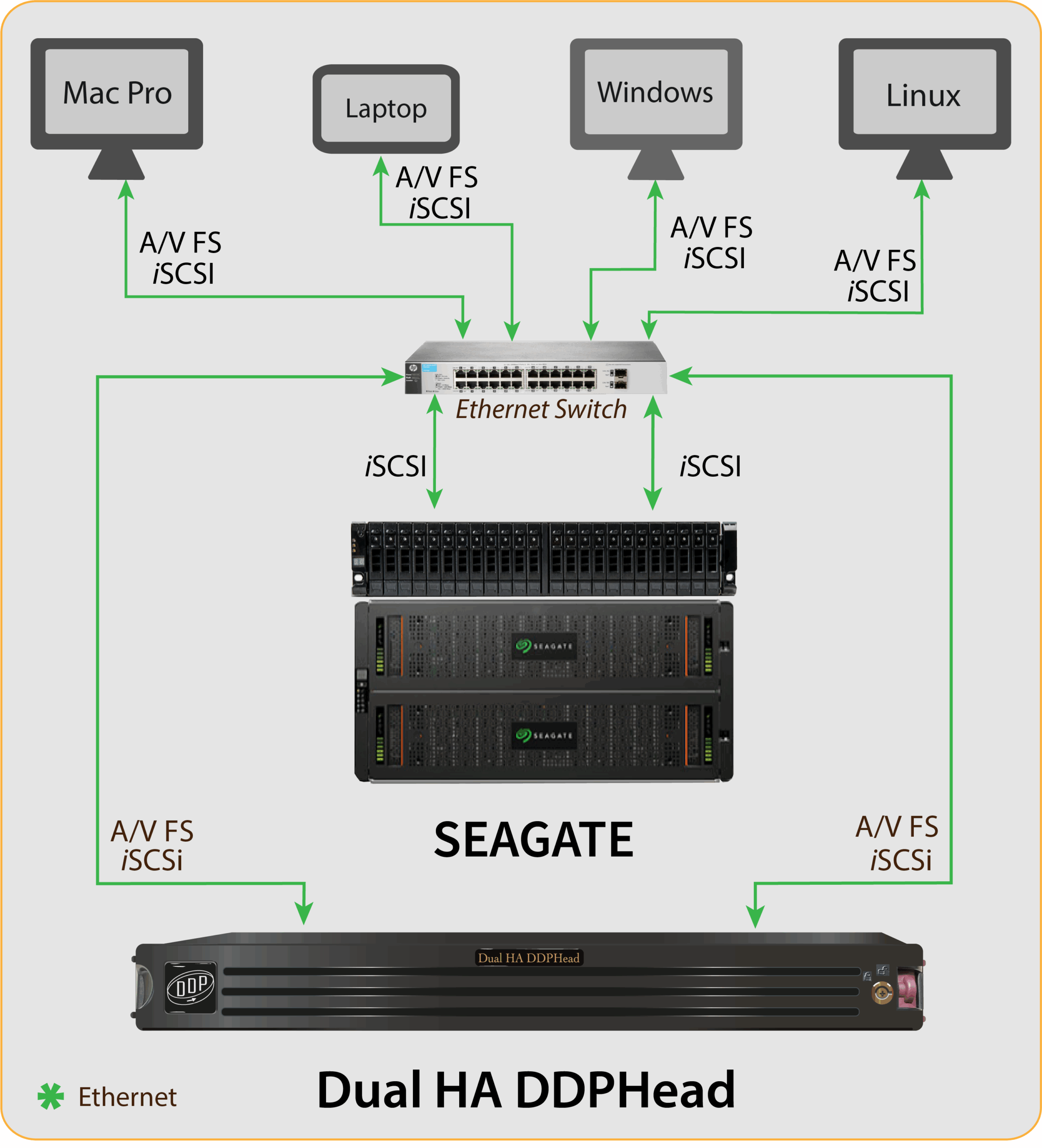
Dual HA DDPHead
Seagate NYTRO X 2U24 and EXOS X 5U84
Now time to show you a mixture of offers and orders. Each case has a detailed description
The broadcaster needed to renew a 300TB of usable capacity Isilon system.
The video format was XDCAM HD (50 Mbps) with 13 editors, 16 live ingest channels and 3 file ingest channels.
Client connections are 1GbE and the connection between storage and switch 10GbE.
We offer a High Availability DDP system with Project Cache to balance performance, size and energy footprint with an affordable price.
The Project Cache consisted of raid 5 protected usable capacity of 11.5 TB.
The hard disk part has 320TB raid6 protected usable capacity.
The system comes with two years warranty, a spare 20TB hard disk, sliding arms and front bezels.
Component breakdown is as follows:
1 x Dual HA DDPHead with 2 x dual port 10/25GbE/SFP28 cards
1 x 24 bay HA DS1024, 4U with 2 x dual 10/25GbE/SFP28 ports
1 x SAS SSD4, 3.84TB as 11.5TBraid 5 protected usable Project Cache
2 x HD8, 20TB packs
1 x HD4, 20TB pack
The hard disks are organized as two Raid 6 sets 10x 20TB drives, usable capacity 320TB.
1x Dual HA DDPHead
1x24bay HA DS1024, 4U
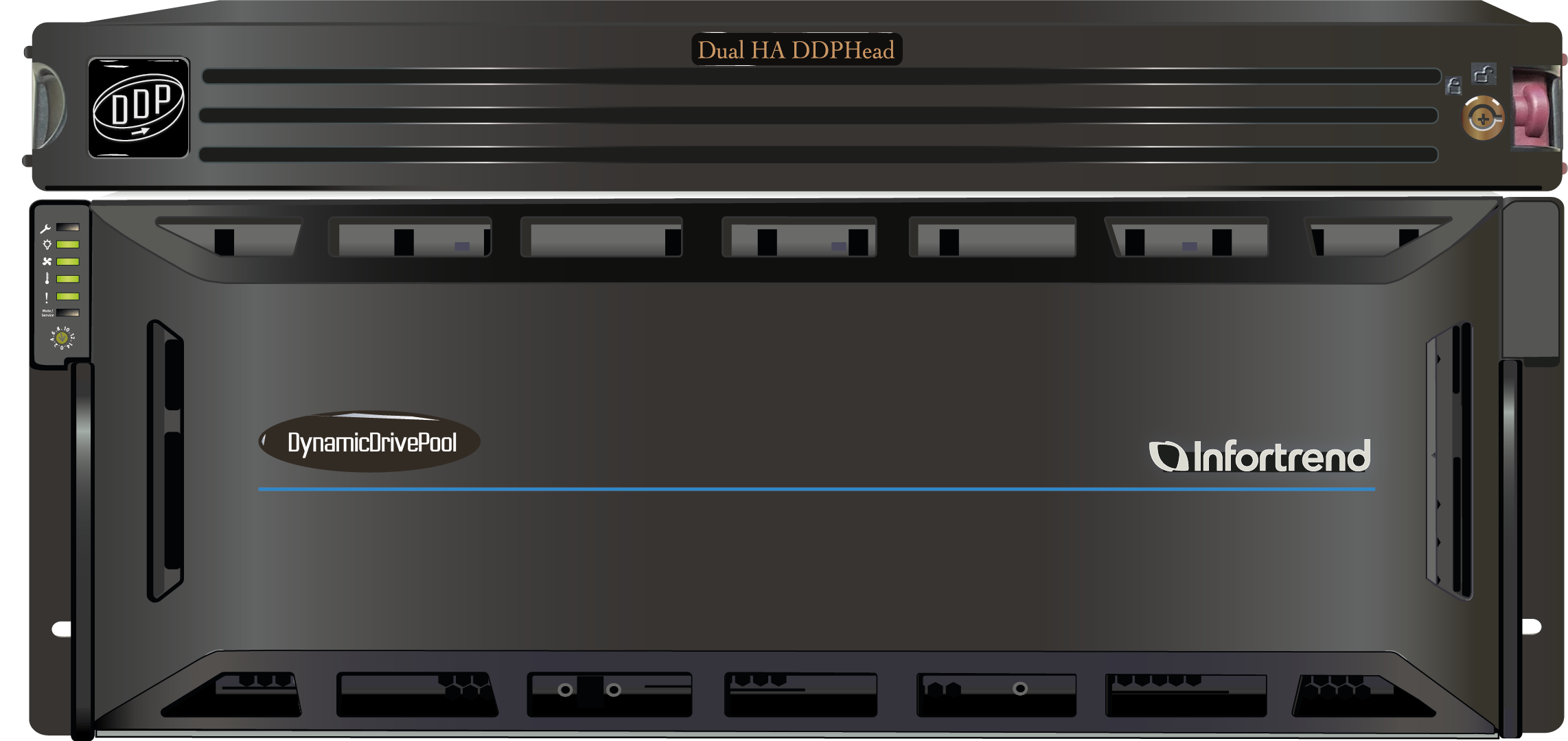
As workflow we proposed to ingest to the Project Cache with automatic copy through to the hard disks.
We also suggest using a folder or folder structure per project. That is the preferred way to use the Project Cache.
At 50Mbit/s bandwidth and 16+3 = 19 ingest streams the capacity requirement per hour is 456GB. So 11500GB Cache can hold 25 hours of each of these 19 streams.
When files are no longer in the cache they are automatically taking from the spindles.
The internal management of the DDP takes care of this and it goes unnoticed for operators and applications.
See the picture for the 5U system.
This broadcaster required a high availability system with 500TB usable capacity and approximately 22GB/s on read and 8GB/s on write
Some 10 clients are to be connected with 25GbE, 15 with 10GbE and 35 with 2.5 GbE. Mac computers used are M2 and M4. Formats range from DPX, JPEG, Apple ProRes 4444, 2k and 4K growing to 6 and 8K. Applications used are Avid Media Composer, Pro Tools, DaVinci Resolve and Adobe Creative Suite.
Further information gives answers to the requirements in the tender document.
1x Dual HA DDPHead
1x HA GS 3024, 4U
2x HA JB 3016, 3U
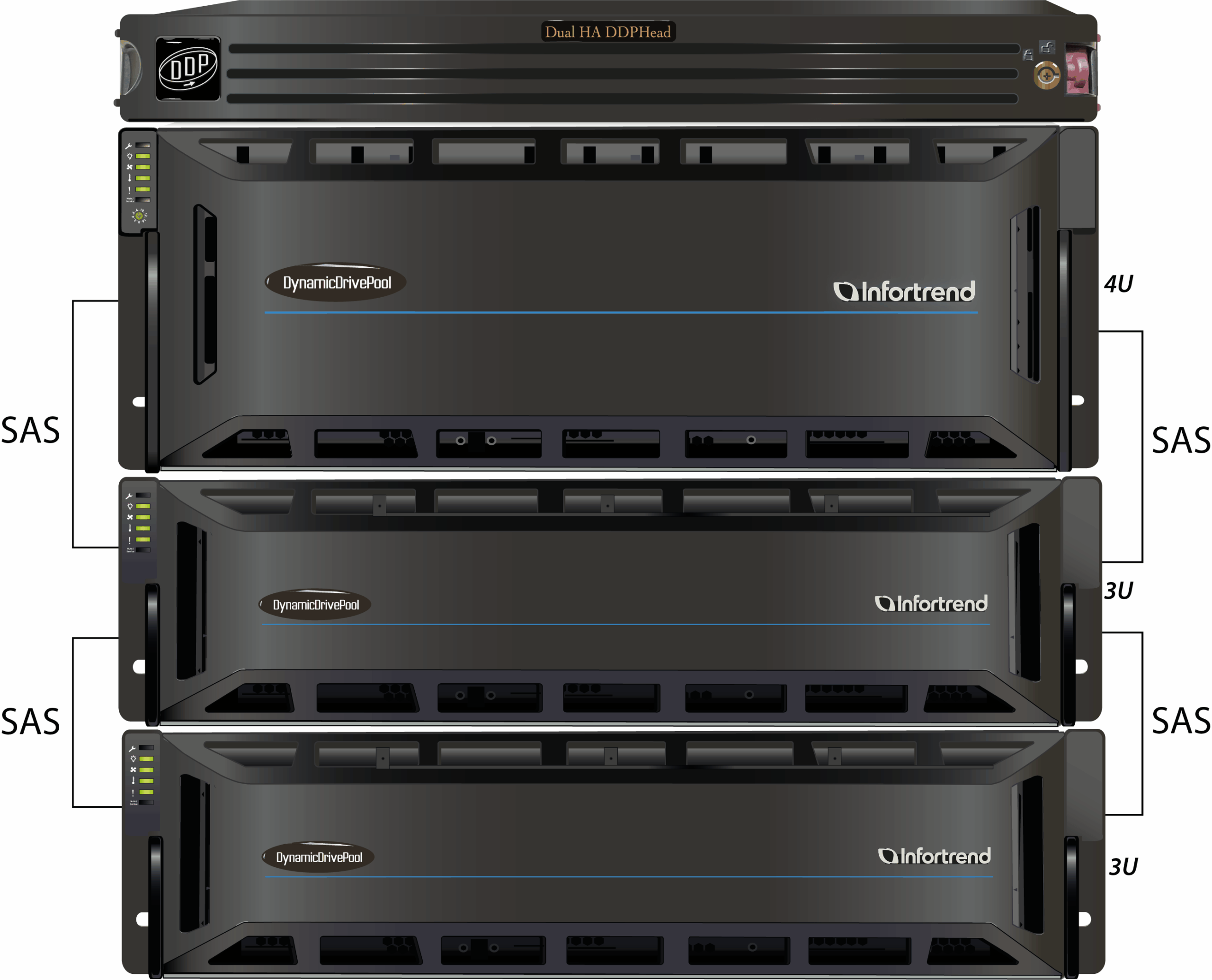
1. The DDPs natively supports Avid bin locking and project sharing. Due to the A/V FS file system the DDP works perfectly with DaVinci Resolve, Pro Tools and Adobe Creative Suite. Underneath the A/V FS file system you can create (sub) folders structures and you can assign volume properties to (sub) folders. Folders with volume properties are called folder volumes. Depending on user/access rights they can appear on the desktop as volumes. Regarding Avid again: each folder volume can hold an Avid MediaFiles directory. Because this is within the A/V FS file system this also means that when a project (folder) is deleted its released capacity automatically becomes available to all. Capacity per project can be controlled via quota. These are main advantages in comparison with Avid Nexis.
2.Quota management on the DDP is per folder volume (project folder which has been given volume properties). When different users work on the same project (for example one doing audio and one doing video and one doing effects you can underneath the project folder make sub folder volumes called for example project audio, project video, project effects and assign quota to each.
3. With the DDP admin can decide which folders and folder volumes should appear upon logon and can also decide which R, W R or R/W no delete access rights a user has. Any project type can be divided up in folder subfolder, subfolder structures with access rights and quota as you see fit.
4. One can expect security issues regarding content that is ingested, especially when it coming via Internet, USB sticks, cartridges etc. DDPs use Linux under the hood and it comes with the latest security updates. DDPs are expected to be on a closed network and there is no need for the DDP to be directly on Internet. We do not deliver the DDP with a virus scanner installed. It would dramatically slow down the required performance and virus scanners cannot normally cope with larger A/V files (limit is around 32GB). Also a virus scanner will not touch files with postfixes such as .exe, .vbs, .cmd, .iso, ips1 and other system file types. To prevent getting malware on the DDP (preventing data corruption, ransom ware or theft of data) the last ring of defense are the desktops connected to the DDP. Apart from desktop measures to secure DDP access (HTTPS, two factor authentication) the DDP comes standard with an audit function, which can be activated. The audit function can be used real time to monitor a specific situation or off line to monitor all user actions.
To secure the ingest via internet Ardis Technologies can offer in addition a Mover/Checker DDP system to prevent malware to enter the company. The Mover/Checker works alongside a preferred virus scanner. In short the Checker checks files against a list of allowed postfixes and it quarantines files with .exe, .cmd, .msi and others. Files, which are allowed after checking are moved to a designated DDP part.
The high availability post production system consists of the Dual HA DDPHead and a GS3024, 4U with 3 x SAS SSD8, 3.84 packs, raid 5 protected usable capacity of 80,4TB Project Cache connected to two JB3016, 3U hard disks arrays with 4 x HD8, 22TB packs, configured as 4 x raid 6 sets of 8 drives, usable capacity: 528TB. Bandwidth on read is 22GB/s and on write 8GB/s.
As workflow we suggest to ingest to the Project Cache with automatic copy through to the hard disks. We also suggest using a folder (sub) folder structure per project. That is the best way to use the Project Cache. We now make two assumptions:
1. Suppose each of the users connected does their own project. So 56 users means 56 projects.
2. Suppose we allow each user an hour of Project Cache space. The 7 x 25GbE clients each doing 4K (1,5 GB/s) then each has a Project folder with quota set to 6TB so total 42TB. Each of the 10GbE users has a project folder with quota set to 3,2TB so total: 32TB. Each of the 35 users is assigned a project quota of 200GB, which is total 7TB. Adding these totals is: 42 + 32 + 7 = 81TB.
The automatic copy through from cache to spindles internally within the DDP proceeds with 4TB/hour given the number of hard disks. When a project is no longer in the cache it is automatically taken from the hard disks.
This next offer below is to be used with 100 clients each with an estimated bandwidth of 300MB/s
So 100 clients each with bandwidth of 300MB/s, so total 30GB/s.
The capacity required was 7.68PB. The applications are FCX, Adobe Premiere Pro, AE, Photoshop and some Maya and Houdini.
Apart from this limited information we also knew that the competition offered an all hard disk system consisting of 30 nodes of 2U and 3 MDCs, 63HE and that it needed to be high availability.
Because of Project Caching we offered a DDP system against less then 50 % of the price compared to the competing system.
The HA DDP system consists of:
1) x Dual HA DDPHead with 2 x dual 100GbE/QSFP28 ports.
2) Large Project Cache consisting of 1 x GS5024,2U with 16 x 30.72 NVME SSDs raid 5 protected usable Project Cache of 430 TB.
3) 7.680PB of hard disks capacity (usable 6.336PB) with 4 x JB3090)
System bandwidth is up to 40GB/s and has 2 x 2 x dual 100GbE/QSFP28 ports on the GS and Dual HA DDPHead. The total rackspace is: 19HE.
The workflow we suggest is as follows:
1. Material is ingested into the cache with automatic copy through to the hard disks.
2. All 100 desktops edit/grade etc. from to the cache.
3. When material is no longer on the cache it is automatically taken from the hard disks.
1x Dual HA DDPHead
1x HA GS5024, 2U
4x HA JB3090, 4U
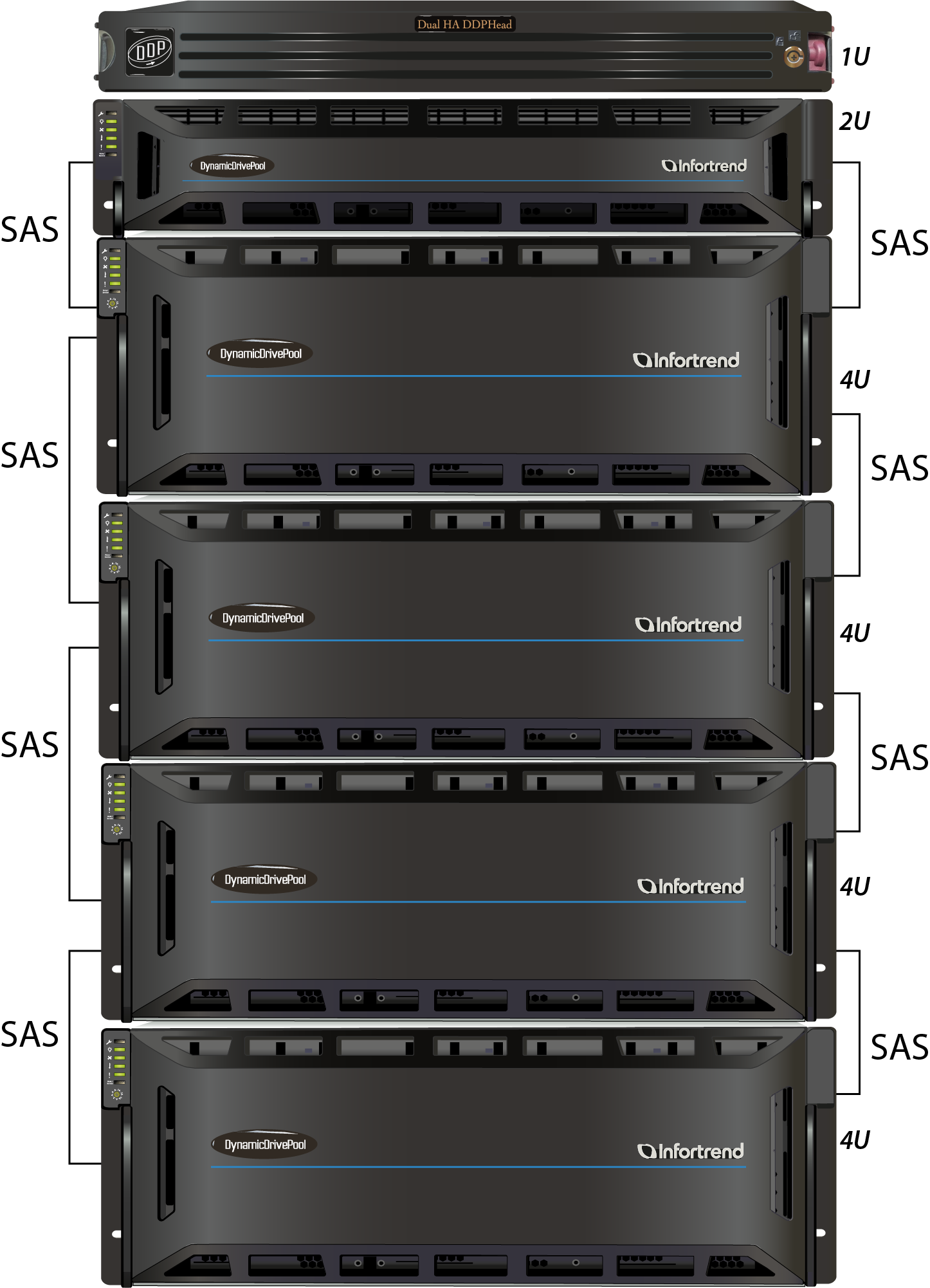
Looking for High Availability, NVME SSDs and High Bandwidth
This HA DDP system was offered confirm a tender requirements such as: high availability , NVME SSDs, high bandwidth on read and write and capacity. The applications themselves nor the workflow was explained. We offered an all NVME SSD system and a setup using Project Caching consisting of NVME SSDs and hard disks. The dealer decided to offer this solution to the customer to limit the costs agains an all dual NVME SSD setup.
1x Dual HA DDPHead
1x HA GS4024, 2U
1x HA JB3090, 4U
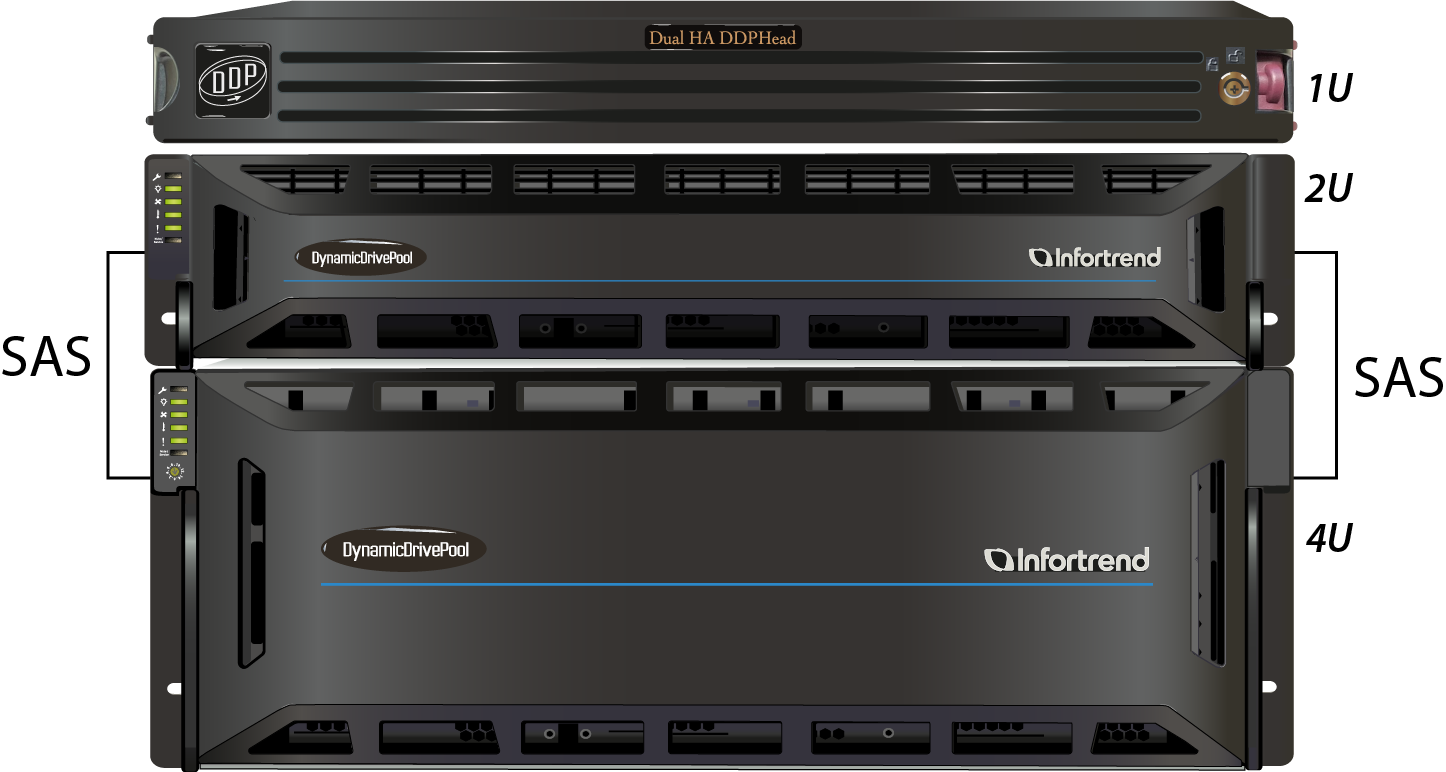
SSD/HD HA DDP system with Project Caching:
Dual HA DDPHead with 2x dual 100GbE/QSFP28 ports, dual controller GS4024 with 2x dual 100GbE/QSFP28 ports, 2U with 737TB NVME SSD raid protected Project Cache capacity and JB3090 with 2,16PB raid protected hard disks capacity
Bandwidth on read: 25GB/s. Bandwdith on write: 15GB/s. Including two year hardware and software warranty ex VAT, installation and transport costs.
High Availability DDP Head
| Dual HA DDP Head | |
|---|---|
 | |
| Content | dual node with 2x dual XEON, 256GB memory, 100 million files/folders and up. |
| Maximum bandwidth | 10 GB/s / node |
| Available PCIe slots | two LP cards plus one SIOM module/node |
| SSD4 or SSD8 packs | two raid 10 SSDs hold the operating system / node |
| HD4 or HD8 packs | - |
| Ethernet cards | 10GbE, 25GbE, 40GbE, 100GbE, 200GbE |
| FC cards | 16, 32, 64 GbE |
| Infiniband cards | on request |
| Other cards | on request |
| DDP dimensions | 72 x 44 x 4,5(h) cm / 28.25 x 17.2 x 1.75 inch |
| DDP power usage | 1000W/2 x dual power supplies |
| Package dimensions | 97 x 76 x 22(h) cm / 38.2 x 29.9 x 8.7 inch |
| Package weight | 28 kg / 61.7 lbs / base system with rails in carton, packed |
| Remark | redundant HA DDP Controller |
High Availability RAID Arrays
| 24 bay redundant array, 4U | 24 bay redundant array, 2U | |
|---|---|---|
 |  | |
| Bandwidth connection | Redundant 2GB/s, 8GB/s, 10, 25 or 100GbE or 16, 32 Gb FC | 2GB/s, 8GB/s, 50 GB/s, 10, 25, 100 GbE or 16, 32 Gb FC |
| SSD4 or SSD8 packs | SSD8 up to 3; 0.96, 1.92, 3.80, 7.68, 15.36, 30.72TB SAS or NVME | SSD8 up to 3; 0.96, 1.92, 3.80, 7.68, 15.36, 30.72TB SAS or NVME |
| HD4 or HD8 packs | HD8: up to 3; 4, 8, 12, 16, 20, 22, 24 TB SAS | |
| DDP dimensions | 45 x 50 x 17,4 cm / 17.7 x 19.7 x 6.9 inch | 45 x 50 x 8,8 cm / 17.7 x 19.7 x 3.5 inch |
| DDP power usage | 460W / dual power supplies | 460W / dual power supplies |
| Package dimensions | 59 x 78 x 47 cm / 23.2 x 30.7 x 18.5 inch | 59 x 78 x 34 cm / 23.2 x 30.7 x 13.4 inch |
| Package weight | 28 kg / 61.7 lbs without drives | 20 kg / 44.1 lbs without drives |
| Remark | For bandwidth up to 2GB/s: DS1024 For bandwidth up to 8GB/s: DS2024 Bandwidth beyond 8GB/s: GS Series Can be expanded with JB3060/3016 | For bandwidth up to 2GB/s: DS1024 For bandwidth up to 8GB/s: DS2024 Bandwidth beyond 8GB/s: GS Series Can be expanded with JB3060/3016 |
High Availability DDP Storage Arrays
| 60 bay redundant array, 4U JB3060 | 16 bay redundant array, 3U JB3016 | |
|---|---|---|
 |  | |
| Connection | Redundant Dual SAS | Redundant Dual SAS |
| SSD4 or SSD8 packs | SSD8 up to 8; 0.96, 1.92, 3.80, 7.68, 15.36, 30.72TB SAS | SSD8 up to 2; 0.96, 1.92, 3.80, 7.68, 15.36, 30.72 TB SAS |
| HD4 or HD8 packs | HD8: up to 8; 4, 8, 12, 16, 20, 22, 24 TB SAS | HD8: up to 2; 4, 8, 12, 20, 22, 24 TB SAS |
| DDP dimensions | 45 x 88 x 17,5 cm / 17.7 x 34.7 x 6.9 inch | 45 x 50 x 17,4 cm / 17.7 x 19.7 x 6.9 inch |
| DDP power usage | 1300 W / dual power supplies | 460W / dual power supplies |
| Package dimensions | 115 x 67 x 63 cm / 45.3 x 26.4 x 24.8 inch | 59 x 78 x 47 cm / 23.2 x 30.7 x 18.5 inch |
| Package weight | 27 kg / 59 lbs without drives | 18 kg / 40 lbs without drives |
| Remark | 90 bay can be ordered additionally or instead |
High Availability DDP Seagate RAID Arrays
| 84 bay redundant array, 5U EXOS X 5U84 | 24 bay redundant array, 2U Nytro X 2U24 | |
|---|---|---|
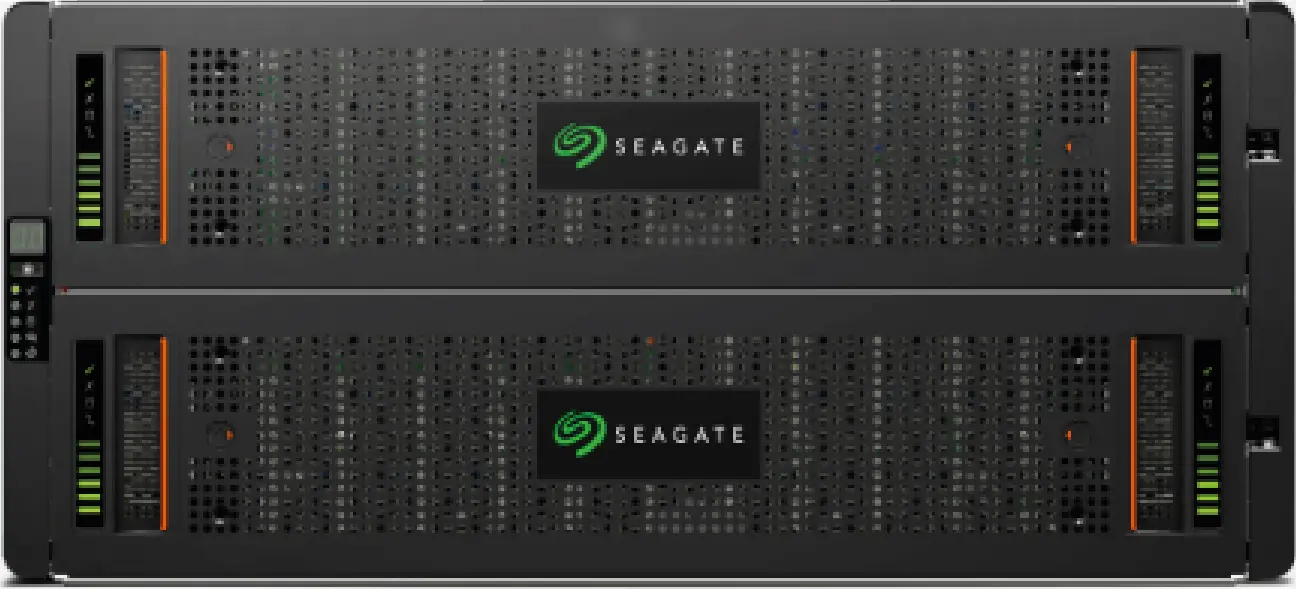 |  | |
| Bandwidth connections | Quad up to 12 GB/s, 10, 25 GbE or 16,32 Gb FC | Quad up to 12 GB/s, 10, 25 GbE or 16,32 Gb FC |
| SSD4 or SSD8 packs | SSD8 up to 11; 0.96, 1.92, 3.80, 7.68, 15.36 TB SAS | SSD8 up to 3; 0.96, 1.92, 3.80, 7.68, 15.36 TB SAS |
| HD4 or HD8 packs | HD8: up to 11, 14, 16, 20 24 TB SAS | |
| DDP dimensions | 45 x 98 x 22,2 cm / 17.5 x 39 x 8.8 inch | 45 x 63 x 8,8 cm / 17.7 x 24.8 x 3.5 inch |
| DDP power usage | 2200 W / dual power supplies | 580 W / dual power supplies |
| Package weight | 82 kg / 180 lbs without drives | 17 kg / 38 lbs without drives |
| Remark | Can be expanded with Seagate storage arrays | Can be expanded with Seagate storage arrays |
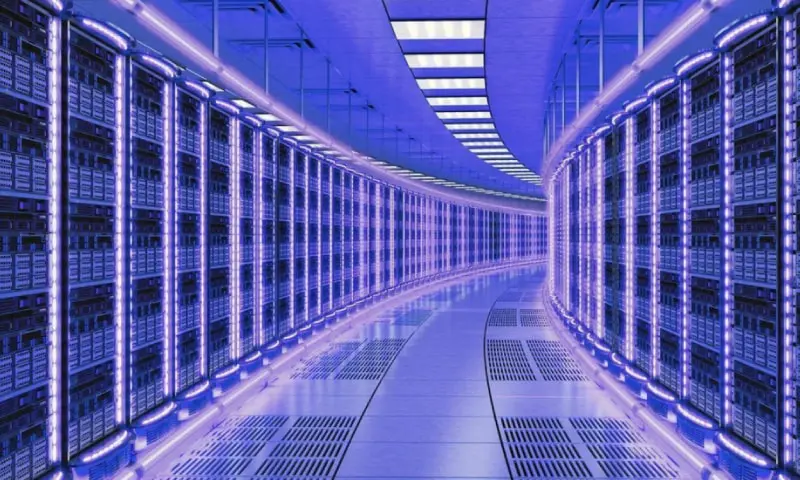
Scaling in Capacity
The HA DDP can be expanded with storage arrays with SSD and HD packs of different capacities. The storage arrays can be added without DDP down time.

Scaling in Bandwidth
Desktops have simultaneous parallel access to all storage arrays. By adding storage arrays the bandwidth can increase in steps of more then 10GB/s., depending on the storage array added.
The HA A/V FS file system is an Ethernet SAN system developed for Media and Entertainment ( M and E )
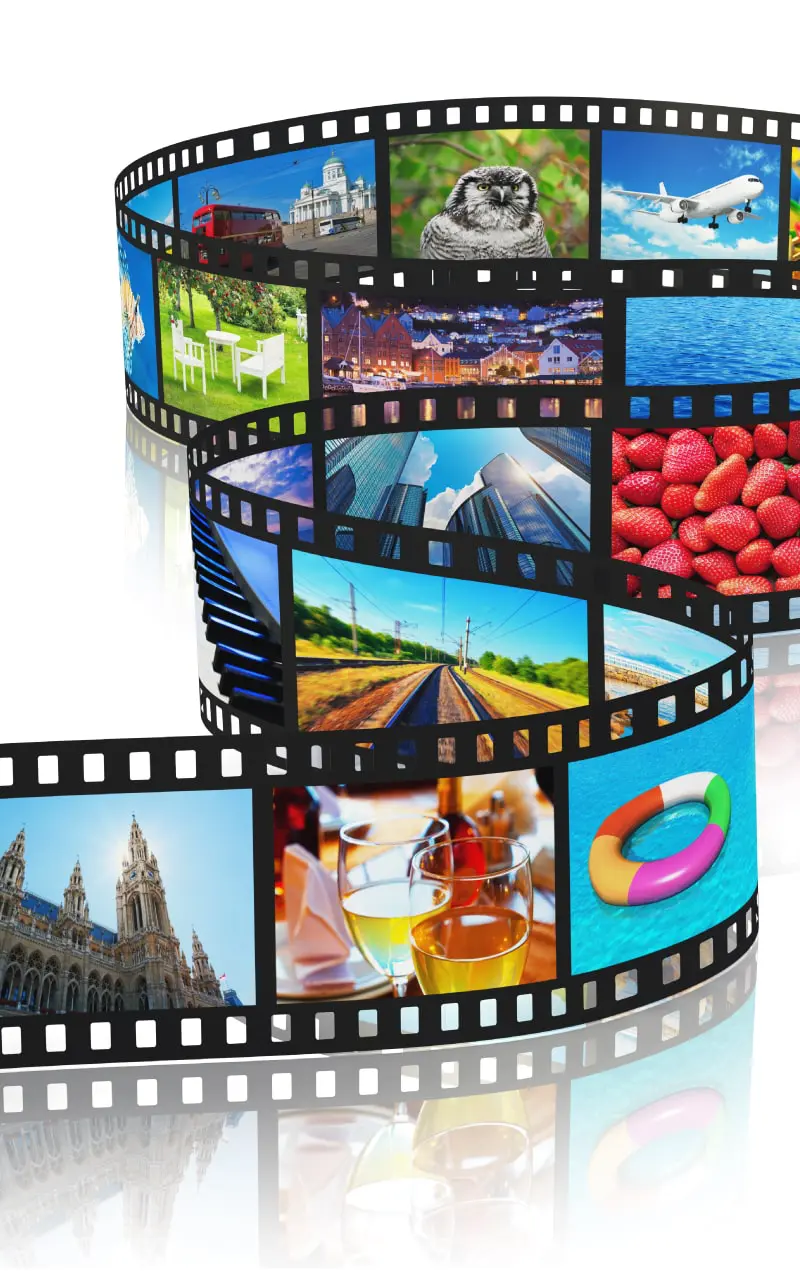
M & E needs uninterrupted high data rates for audio, video and film files over Ethernet. This can only be guaranteed with block IO (SAN) data access. Often in data centers the standard protocol for this is iSCSI. So iSCSI is a perfect choice.
To be able to share storage (shared storage server) a file system/metadata system was needed with the following requirements:
- Must be a single file system which independently can be scaled in performance and capacity
- Must have a small footprint and able to handle metadata fast with minimal overhead
- File system/metadata must be independent and separate from data containers
- Must have data access in parallel between clients and storage arrays
- Must be able to integrate with different types and brands of storage arrays
- Must be able to integrate SSD and HD packs of differing capacities for a competitive performance-price ratio
- Must have a directory/folder based access right and quota management system
- Must have project based SSD caching
- Must have the ability to move data between tiers transparent for clients
- Must have transparent data and/or metadata failover capability for writing and reading transparent for clients.
When Ardis Technologies realised that these requirements were not met in the file systems available on the market the decision was made to develop their own. Since more then 10 years now DDPs are delivered with A/V FS on board and it has evolved into what it currently offers including its project caching and high availability features.

Seagate
and Dual HA DDPHead
Dual HA DDPHead and Seagate Raid Arrays:
Transparant failover, Scale out, Single file system A/V FS,
Use of iSCSI and FC,
Parallel data access, Wire speed

Infortrend
and Dual HA DDPHead
Dual HA DDPHead and Infortrend Raid Arrays:
Transparant failover, Scale out, Single file system A/V FS,
Use of iSCSI or FC, Parallel data access, Wire speed
The EXOS series of Seagate and the DS series of Infortrend have been tested and certified. See the product information pdf’s.
EonStor DS Family – Enterprise-Class High Availability SAN Storage
More information about Infortrend DS Storage Products
Infortrend DS Storage Arrays
EonStor DS is a high-availability SAN storage solution designed for enterprises. Its hardware design features multiple form factors, symmetric active-active controllers, flexible host boards to choose from, and reliable modular design with high expandability.
The management software comes with complete data services and an easy-to-use management interface. EonStor DS is ideal for all SAN environments and enterprise applications (e.g. database, virtualization, video editing, backup, and surveillance) to meet your performance or budget needs.
The datasphere’s favorite entry-level solution for right-sized storage performance at an exceptional price point:
More information about Seagate Storage Products
Seagate® ExosTM X 2U24
Product Highlights
- Expand a data center seamlessly with flexible hard drive and hybrid flash configuration options
- Efficiently manage hot and cold data with real-time data tiering feature option
- Deliver unfettered data access with dual redundant controllers capable of achieving up to 7GB/s sequential read, 5.5GB/s sequential write performance
- Rebuild drives faster than ever and reduce downtime with Seagate ADAPT data protection technology
- Opt for replication and snapshot features to meet critical enterprise requirements.
The datasphere’s ultra-dense, intelligent solution for maximum capacity and performance at an exceptionally low TCO:
More information about Seagate Storage Products
Seagate® ExosTM X 5U84
Product Highlights
- Expand a data center seamlessly with single enclosures that host up to 84 drives each and connect up to four enclosures that can host up to 336 drives (6.04PB using 18TB drives). Capacity varies with drives used.
- Efficiently manage hot and cold data with real-time data tiering option
- Deliver unfettered data access with dual redundant controllers capable of achieving up to 7GB/s sequential read, 5.5GB/s sequential write performance
- Rebuild drives faster than ever and reduce downtime with Seagate ADAPT data protection technology
- Opt for replication and snapshot features to meet critical enterprise requirements.
CEO Jan de Wit about the Dual HA DDPHead
A/V FS as a HA SAN file system integrates storage arrays under the hood of a single file system. It offers file sharing with parallel access and file based caching and tiering to maximise storage efficiency and minimise costs. It can manage storage arrays connected with Ethernet, RoCE, FC, InfiniBand and combinations of these.

Data storage is undergoing a speed revolution. Flash media and faster interfaces like NVME are overwhelming traditional Fibrechannel and Ethernet Networks. Faster servers, analytics, artificial intelligence (AI), deep learning, machine learning, health care / life science / genomics, M and E, gaming workloads demand extreme performance per client of 20 GB/s bandwidth and latency as low as 1µsec.

Customers are more and more deploying extremely fast storage using NVME over Fabrics (NVME-oF) / RDMA.

State of the art building blocks come from Infortrend and Seagate.
Take the power of A/V FS, save money on premises and integrate NVME-oF or FC storage arrays with iSCSI storage arrays within a single file system

FAQ


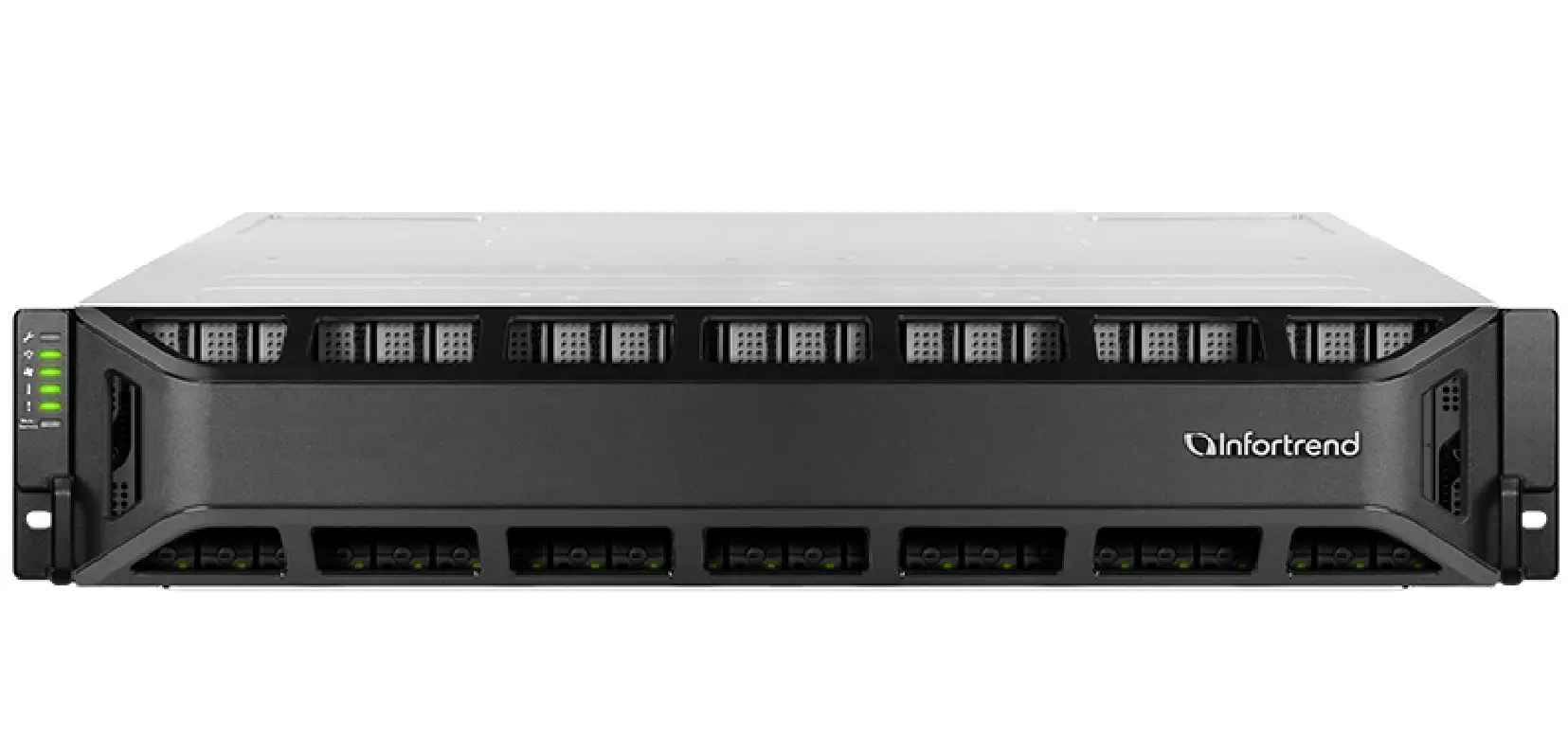

HA DDP comes with HA A/V FS on board. HA AVFS is managed by admin using the web interface. Although possible, there is no need for users to be confronted with the web interface.
HA A/V FS is an in house development of Ardis Technologies. This has the advantage that issues can be solved without having to consult another party. A short reaction time is guaranteed this way. HA A/V FS is the property of Ardis Technologies, manufacturer of the Dynamic Drive Pool, in short DDP series of storage servers
Yes. SNMP servers and other storage monitoring devices can be used.
Archiware P5 comes standard as part of A/V FS. In a smaller setup P5 can be used to control a tape streamer or other SAS equipped library device. Or it can be used as client. When HA AVFS is used it is best to use a separate P5 server and mount HA A/V FS ddp volume via iSCSI/A/V FS.
AD, OD user names can be imported and be kept synchronized. Authentication is via AD or OD. Access rights and other attributes for these users are created and managed in A/V FS.
HA A/V FS runs on Linux and also supports SMBI, FC and NVME-oF/RDMA. It includes the standard up to date Linux SMB server, which internally in the Dual DDP Head is connected via iSCSI. When SMB is used both data and metadata is routed via the Dual DDP Head while iSCSI / A/V FS , FC, NVME-oF/RDMA access the data in parallel. When using SMB scale out and transparent data failover is not supported.
A/VF S in combination with a Dual DDP Head can be used to cluster iSCSI, FC and Infiniband storage systems although the preferred protocol is iSCSI. The systems then function as data containers managed by A/V FS.
HTTPS and two-factor authentication can be used for logon. A/V FS file system remains in the DDP separate from the data and is never exposed to desktops. Operators only get to see a representation required for the Folder Volume mounted. A/V FS and iSCSI can be physically separated using different network ports and subnets. Also hardware based hard disk encryption can be used when proper hard disks are used. A/V FS is ISO 27001 and MPAA compliant. Auditing information is assembled during operation and does not need to be generated afterwards.
The play out should always go on. Therefore it is best to play out from SSD cache and cache material needed for play out using pinned so that it is available in time in the cache.
Ingest should continue uninterrupted no matter what with the media securely stored. Possible interruption can come from hard and software and hard disks issues. HA DDP assures that when there is hard or software failure ingest during a fail over continuous without hick up. In addition a Data Location can be optionally kept aside which can be used when one of the disks within a Data Location becomes too slow.
HA DDP fails over transparent for users including MAM servers. DDP uses a single file system with one directory/folder tree. If the MAM server connects with ddpvolume there are just (sub)folders to consider. A/V FS also supports hard-links. Hard-links in combination with the single file system is ideal for MAM systems. Also without workflow interruption bandwidth and or capacity can be increased or maintenance can be done.
Almost all file systems have an ACL per file per user. A/V FS uses ACLs per folder per user. For almost all activity in the M & E industry the property of a directory/folder is leading. Having ACL on directories/folders simplifies handling of access rights.
Various MAM applications benefit when a storage system supports hard-links. A/V FS supports hard-links. Both hard-links and the single file system allow MAM and other applications to optimally use hard-links in their workflow.
A/V FS is a single file system. It is separate from the storage arrays with the Data Locations it manages. A desktop has parallel access to these storage arrays of which its Data Locations behave independently. So the total bandwidth is the sum of the bandwidth of the storage arrays. Also capacity can be increased separately. So yes, A/V FS is a scale out file system.
Data access is in parallel using one or more Ethernet connections and as a standard using the iSCSI protocol. Other protocols supported are SMB, FC and NVME-oF / RDMA
On the desktop on Mac and in Linux volumes are displayed. On windows volumes are in My Computer. These volumes are folders on the file system, which have been given volume properties. These are therefore called Folder Volumes.
On the desktop on Mac and in Linux Volumes are shown. On windows Volumes are in My Computer. These Volumes are folders, which have been given Volume properties in the A/V FS web interface, so called Folder Volumes.
A Folder Volume represents a folder on the file system. The data of files and subfolders and files displayed in the directory of such Folder Volume are on one of more Data Locations on the storage arrays.
These Data Locations are shown in Disk Utility on the Mac and in Computer Management on Windows.
Many systems with multiple nodes divide a file in blocks to spread over the nodes to balance the bandwidth. In that case all data must be present in the desktop before a file can be used. A/V FS keeps a file within a Data Location boundary and a node can have multiple Data Locations. So also smaller A/V FS setups can still benefit from load balancing. And to scale out storage nodes of different brands, capacities and manufacturing dates can be added.
A/VF S uses Project Caching. The caching technology called Dual Path is build-in in the AVFS file system. On playback a file is either coming from the cache or coming from the spindles. Or a complete file can be copied or ingested to the cache and duplicated to the spindles. If no longer in the cache the file is taken from the spindles. Caching, cache mode and direction are selectable per directory/folder.
The vast majority of systems use block level caching. There is no way of knowing to which file the data belongs. So the basic criteria, to keep data cached, is how often data blocks are used. Because parts of a file could be in the cache and other parts not, this could lead to unexpected play back interruptions. There is also no mechanism for file prioritization.
Yes. A/V FS is an Ethernet SAN system with a single file system with one directory/folder tree. The available storage can be used up to 100 % and there is no pre-allocation. When more physical storage is added it automatically becomes available within A/V FS.
One name space mostly describes a system which underneath combines multiple file systems. Such system has scaling, capacity and data movement limitations.
Single file system means that there is only one directory/folder tree giving access to all data no matter where it is. Data can be moved between Data Locations without changes to the directory/folder tree and transparent for the users.
With a SAN file system both data and the file system (metadata) are kept and managed separate. Data is stored as raw data in Data Locations. The single file system A/V FS is elsewhere and holds information, on which Data Location the data can be found.
Unfortunately open source file systems such as XFS, ZFS and others cannot be easily tuned so that it can live up to M & E situations.
Ethernet is what everybody uses and is thus affordable. SCSI over Ethernet (iSCSI) is an established SAN protocol. Ethernet cards and switches are available up to 100 GbE/s bandwidth at affordable prices. Installing an Ethernet SAN system is easy nowadays.
To get the highest possible data bandwidth over a network the connection should not carry metadata. Or the amount of metadata should be controllable and as low as possible. This is possible when data and metadata can be handled separately. Only a SAN file system can guarantee this.
–
HA DDPs can be purchased through DDP distributors and dealers. ICT companies, OEMs and integrators interested in purchasing a file system specially developed for M & E applications can E-mail us, please go to Contact.
